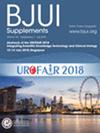A structured training curriculum for robot-assisted radical nephroureterectomy: a Delphi consensus study.
IF 4.4
2区 医学
Q1 UROLOGY & NEPHROLOGY
引用次数: 0
Abstract
OBJECTIVES To develop an internationally validated, structured robot-assisted radical nephroureterectomy (RARNU) training programme through expert consensus. MATERIALS AND METHODS A RARNU-specific questionnaire was developed/adapted from previously published, validated questionnaires for robot-assisted urological procedures. This included five key domains and 11 surgical steps. In all, 30 upper tract urothelial carcinoma experts were invited to participate. A two-stage modified Delphi approach was employed. Consensus was defined as ≥80% agreement. Modifications and additional statements were proposed during the second round following qualitative/quantitative feedback from the initial round. RESULTS Response rates for the first and second Delphi rounds were 80% (24/30) and 92% (22/24), respectively. All agreed that adoption of a standardised training curriculum can improve clinical outcomes during the RARNU learning curve. There was ≥92% agreement on all proposed RARNU steps. Five RARNU clinical modules of increasing complexity were defined using individual step difficulty and number of prior RARNU cases required, with ≥96% agreement among respondents. Respondents unanimously agreed that the final assessment should be based on a procedure-specific scale focusing on the hilar dissection, ureteric dissection, and bladder cuff excision steps. No consensus was reached for the annual minimum RARNU volume required for eligibility as a RARNU curriculum host centre. CONCLUSION This is the first structured training curriculum for RARNU using international expert consensus. This will help guide surgical educators and trainees toward independent completion of a full RARNU.机器人辅助根治性肾输尿管切除术的结构化培训课程:德尔菲共识研究。
目的:通过专家共识,制定一个国际认可的、结构化的机器人辅助根治性肾输尿管切除术(RARNU)培训计划。材料和方法根据先前发表的、经过验证的机器人辅助泌尿外科手术问卷,开发/改编了一份rarnu特异性问卷。这包括5个关键领域和11个手术步骤。总共邀请了30位上尿路上皮癌专家参加。采用两阶段改进的德尔菲法。一致定义为≥80%的同意。根据第一轮的定性/定量反馈,在第二轮中提出了修改和补充说明。结果第一轮和第二次德尔菲调查的应答率分别为80%(24/30)和92%(22/24)。所有人都同意采用标准化培训课程可以改善RARNU学习曲线期间的临床结果。所有建议的RARNU步骤的一致性≥92%。根据个体步骤难度和需要的RARNU病例数,定义了五个日益复杂的RARNU临床模块,受访者之间的一致性≥96%。受访者一致同意,最终的评估应基于一个特定的程序尺度,侧重于肝门剥离、输尿管剥离和膀胱袖切除步骤。对于成为RARNU课程托管中心所需的年度最低RARNU数量没有达成共识。结论这是RARNU第一个采用国际专家共识的结构化培训课程。这将有助于指导外科教育者和受训者独立完成完整的RARNU。
本文章由计算机程序翻译,如有差异,请以英文原文为准。
求助全文
约1分钟内获得全文
求助全文
来源期刊

BJU International
医学-泌尿学与肾脏学
CiteScore
9.10
自引率
4.40%
发文量
262
审稿时长
1 months
期刊介绍:
BJUI is one of the most highly respected medical journals in the world, with a truly international range of published papers and appeal. Every issue gives invaluable practical information in the form of original articles, reviews, comments, surgical education articles, and translational science articles in the field of urology. BJUI employs topical sections, and is in full colour, making it easier to browse or search for something specific.
 求助内容:
求助内容: 应助结果提醒方式:
应助结果提醒方式:


